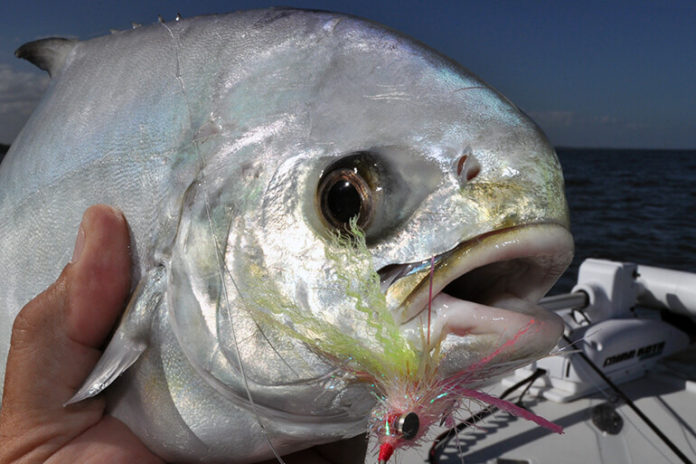Add pompano to the Florida fly fishing menu.
The best time and place to catch pompano on fly is when the fish enter bays and coastal rivers.
Pompano create a buzz when they migrate south along Florida shores in the fall. Not only are they delicious, but they also fight hard for their size. Conventional surf casters fervently pursue these fish, and on a calm, clear day, it’s possible to catch them on flies in the surf (summer in the Florida Panhandle comes to mind). But I think the best time and place to catch pompano on fly is when the fish enter bays and coastal rivers in the southern peninsula—places like the Indian River Lagoon, Loxahatchee River, Pine Island Sound, Sarasota Bay and Tampa Bay.
Pompano seem to move non-stop, but do get into ambush mode much like bass or snook. One thing they often do is settle into bridge channels where current funnels prey to them. Spin fishermen can often be spotted casting jigs and baits in these places; watch them and you might notice they get more hookups just down-tide of bridge pilings than in the open. Tough to fly fish in places like this; you’d need fast-sinking fly lines and heavy flies. Not my favorite means.
GO SHALLOW
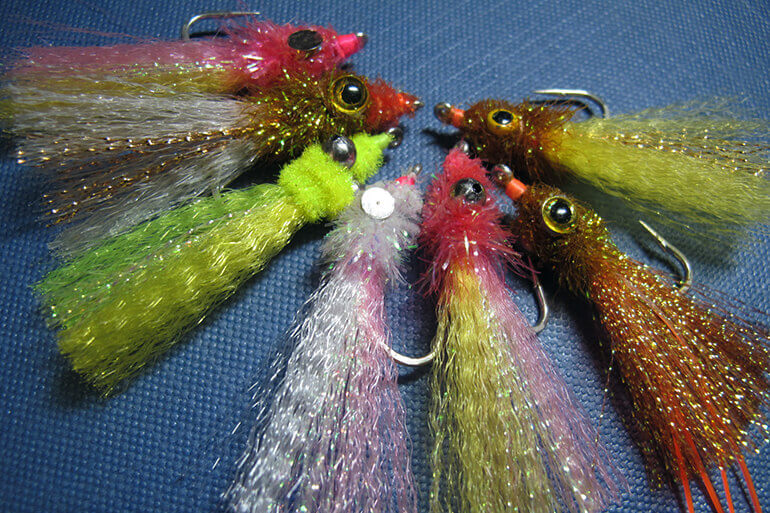
Some good options when you have pompano in mind.
Concentrate your search on the grassy flats that hold spotted seatrout, redfish and others, especially in proximity to inlets that have good tidal flow and shell and sandy bottom. The submerged or emergent spoil islands of the Intracoastal Waterway are terrific spots—pompano, like permit, love small crabs and clams that live on bottom. They also forage on small baitfish that school over the shoals. Sight fishing with floating or intermediate-sinking lines is exciting, when water clarity allows for it.
Migratory pompano enter the Intracoastal Waterway (ICW) via inlets in November and action peaks from January until April. The fish will stay put so long as water temps do not fall into the mid 60s, at which time they head south in the ICW and I suspect, leave the inside to get into warmer surf water. I find best fishing is when water temp is 70 to 78.
TACKLE
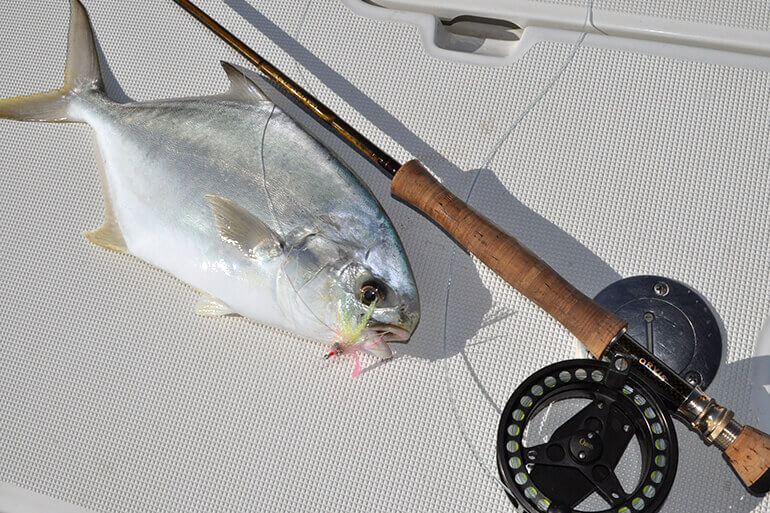
Sight fishing pompano is possible at times, but working favorable waters with a weighted pattern and line of appropriate sink rate will take many fish.
I fish an 8-weight with intermediate clear line for the shallow flats up to 3 feet deep, and a 9-weight with a medium-sink line for casting heavy flies in water over 5 feet deep. Sinking lines allow for a 4- to 5-foot leader. I use a strand of 20-pound fluorocarbon or mono with clear lines. When I sight fish with a floating line, I loop on a 4-foot, 30-pound-test butt section blood-knotted to a 3-foot, 15- to 20-pound-test tippet. When ladyfish or small blues are mixed in, I fish a 30-pound-test tippet to deter abrasion.
I tie my flies on No. 2 or No. 1 hooks, designed to look like the popular pompano jigs in size and color (see pics). My favorites have bright-colored synthetic fibers and small lead dumbbell eyes, a good combo for fast sinking in current.
FISH-FINDING TIPS
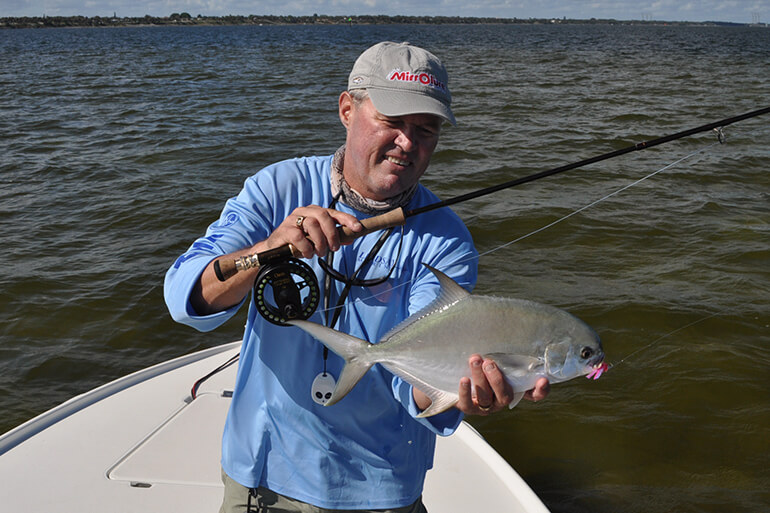
Author with a nice lagoon pomp.
While blind-casting in deeper water, simply drift with the wind and current. Once you hook up, slip the anchor over or lower a stake anchor to stay in the zone. Always fish over mullet muds or baitfish on the surface. Ladyfish tend to mix with pomps, so you may have to endure them during a hot pomp bite. To attract fish during a slow bite, or when extreme boat pressure makes them spooky, I break out the chum bag with crushed fresh or blanched frozen sand fleas or clam meat. I have watched “scent-drunk” pompano bang into the bag, and often skip out of the water right at the stern.
When poling or electric motoring over shallow flats, look for rays, small schools of mullet and catfish. Pompano might be nearby. Like permit and bonefish, pompano often trail stingrays, particularly those actively mudding. A well-placed fly over a ray’s back will get eaten! FS
Published Florida Sportsman Magazine December/January 2021

Crabs can make up as much as 70 percent of a redfish’s diet in many areas along the Florida coast. Shallow grassflats and mangrove prop roots offer ideal habitat for a variety of crabs. Redfish and …
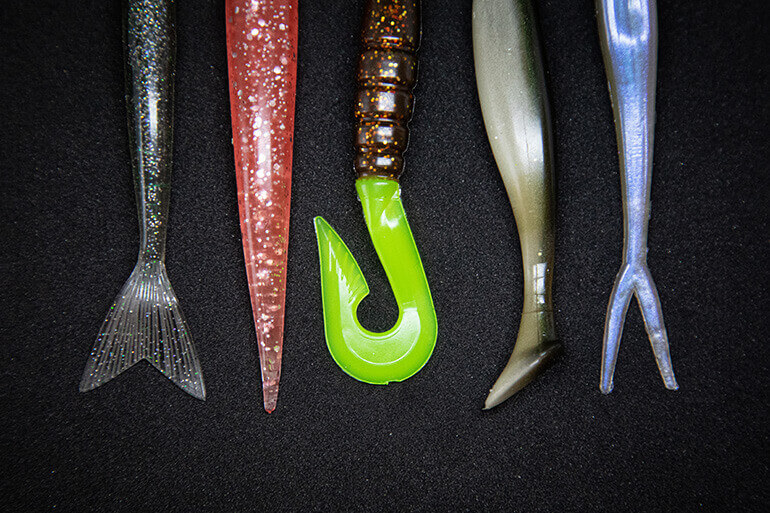
How do different tail shapes move soft plastic baits and provoke fish? What plays the biggest role in a soft plastic? The tail. The tail provides the action…
Credit: Source link

















